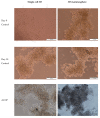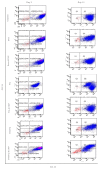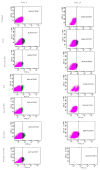Cockle Shell-Derived Aragonite CaCO3 Nanoparticles for Co-Delivery of Doxorubicin and Thymoquinone Eliminates Cancer Stem Cells
- PMID: 32164352
- PMCID: PMC7084823
- DOI: 10.3390/ijms21051900
Cockle Shell-Derived Aragonite CaCO3 Nanoparticles for Co-Delivery of Doxorubicin and Thymoquinone Eliminates Cancer Stem Cells
Abstract
Cancer stem cells CSCs (tumour-initiating cells) are responsible for cancer metastasis and recurrence associated with resistance to conventional chemotherapy. This study generated MBA MD231 3D cancer stem cells enriched spheroids in serum-free conditions and evaluated the influence of combined doxorubicin/thymoquinone-loaded cockle-shell-derived aragonite calcium carbonate nanoparticles. Single loaded drugs and free drugs were also evaluated. WST assay, sphere forming assay, ALDH activity analysis, Surface marker of CD44 and CD24 expression, apoptosis with Annexin V-PI kit, cell cycle analysis, morphological changes using a phase contrast light microscope, scanning electron microscopy, invasion assay and migration assay were carried out; The combination therapy showed enhanced apoptosis, reduction in ALDH activity and expression of CD44 and CD24 surface maker, reduction in cellular migration and invasion, inhibition of 3D sphere formation when compared to the free drugs and the single drug-loaded nanoparticle. Scanning electron microscopy showed poor spheroid formation, cell membrane blebbing, presence of cell shrinkage, distortion in the spheroid architecture; and the results from this study showed that combined drug-loaded cockle-shell-derived aragonite calcium carbonate nanoparticles can efficiently destroy the breast CSCs compared to single drug-loaded nanoparticle and a simple mixture of doxorubicin and thymoquinone.
Keywords: breast cancer; cancer stem cell; doxorubicin; nanoparticle; thymoquinone.
Conflict of interest statement
The authors declare no conflict of interest. The funders had no role in the design of the study; in the collection, analyses, or interpretation of data; in the writing of the manuscript, or in the decision to publish the results.
Figures























Similar articles
-
Ultrastructural Changes and Antitumor Effects of Doxorubicin/Thymoquinone-Loaded CaCO3 Nanoparticles on Breast Cancer Cell Line.Front Oncol. 2019 Jul 3;9:599. doi: 10.3389/fonc.2019.00599. eCollection 2019. Front Oncol. 2019. PMID: 31334120 Free PMC article.
-
Formulation of a Sustained Release Docetaxel Loaded Cockle Shell-Derived Calcium Carbonate Nanoparticles against Breast Cancer.Pharm Res. 2017 Jun;34(6):1193-1203. doi: 10.1007/s11095-017-2135-1. Epub 2017 Apr 5. Pharm Res. 2017. PMID: 28382563
-
Combination therapy with epigenetic-targeted and chemotherapeutic drugs delivered by nanoparticles to enhance the chemotherapy response and overcome resistance by breast cancer stem cells.J Control Release. 2015 May 10;205:7-14. doi: 10.1016/j.jconrel.2014.11.011. Epub 2014 Nov 15. J Control Release. 2015. PMID: 25445694
-
Breast cancer stem cells and intrinsic subtypes: controversies rage on.Curr Stem Cell Res Ther. 2009 Jan;4(1):50-60. doi: 10.2174/157488809787169110. Curr Stem Cell Res Ther. 2009. PMID: 19149630 Review.
-
Triterpene Acid (3-O-p-Coumaroyltormentic Acid) Isolated From Aronia Extracts Inhibits Breast Cancer Stem Cell Formation through Downregulation of c-Myc Protein.Int J Mol Sci. 2018 Aug 26;19(9):2528. doi: 10.3390/ijms19092528. Int J Mol Sci. 2018. PMID: 30149665 Free PMC article. Review.
Cited by
-
Therapeutic potential of thymoquinone in combination therapy against cancer and cancer stem cells.World J Clin Oncol. 2021 Jul 24;12(7):522-543. doi: 10.5306/wjco.v12.i7.522. World J Clin Oncol. 2021. PMID: 34367926 Free PMC article. Review.
-
Development of Responsive Nanoparticles for Cancer Therapy.Int J Mol Sci. 2023 Jun 20;24(12):10371. doi: 10.3390/ijms241210371. Int J Mol Sci. 2023. PMID: 37373517 Free PMC article.
-
Eradicating the tumor "seeds": nanomedicines-based therapies against cancer stem cells.Daru. 2023 Jun;31(1):83-94. doi: 10.1007/s40199-023-00456-0. Epub 2023 Mar 27. Daru. 2023. PMID: 36971921 Free PMC article. Review.
-
Progress in Natural Compounds/siRNA Co-delivery Employing Nanovehicles for Cancer Therapy.ACS Comb Sci. 2020 Dec 14;22(12):669-700. doi: 10.1021/acscombsci.0c00099. Epub 2020 Oct 23. ACS Comb Sci. 2020. PMID: 33095554 Free PMC article. Review.
-
Nanosized Drug Delivery Systems for Breast Cancer Stem Cell Targeting.Int J Nanomedicine. 2021 Feb 23;16:1487-1508. doi: 10.2147/IJN.S282110. eCollection 2021. Int J Nanomedicine. 2021. PMID: 33654398 Free PMC article. Review.
References
-
- Ginestier C., Liu S., Diebel M.E., Korkaya H., Luo M., Brown M., Wicinski J., Cabaud O., Charafe-Jauffret E., Birnbaum D., et al. CXCR1 blockade selectively targets human breast cancer stem cells in vitro and in xenografts. J. Clin. Investig. 2010;120:485–497. doi: 10.1172/JCI39397. - DOI - PMC - PubMed
MeSH terms
Substances
LinkOut - more resources
Full Text Sources
Medical
Research Materials
Miscellaneous

